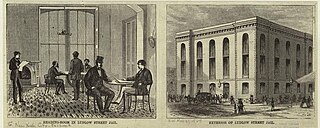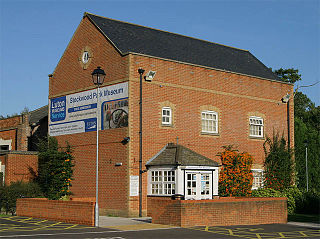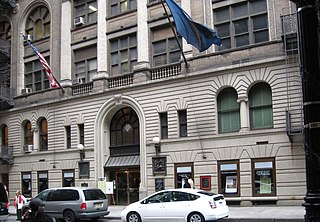
The Saint Lawrence Seaway is a system of locks, canals, and channels in Canada and the United States that permits oceangoing vessels to travel from the Atlantic Ocean to the Great Lakes of North America, as far inland as Duluth, Minnesota, at the western end of Lake Superior. The seaway is named for the Saint Lawrence River, which flows from Lake Ontario to the Atlantic Ocean. Legally, the seaway extends from Montreal, Quebec, to Lake Erie, and includes the Welland Canal.

The Museum of the City of New York (MCNY) is a history and art museum in Manhattan, New York City, New York. It was founded by Henry Collins Brown, in 1923 to preserve and present the history of New York City, and its people. It is located at 1220–1227 Fifth Avenue between East 103rd to 104th Streets, across from Central Park in Manhattan's Upper East Side, at the northern end of the Museum Mile section of Fifth Avenue.

The Thomson-Houston Electric Company was a manufacturing company which was one of the precursors of the General Electric company.
The Lock Museum of America houses an extensive lock collection that includes 30 early era time locks, escutcheon plates from safes, a large number of British safe locks, door locks, padlocks, handcuffs and keys, and more. Located in Terryville, Connecticut, the museum is directly across from the original site of the Eagle Lock Company, founded in 1854.

Anna Vaughn Hyatt Huntington was an American sculptor and was once among New York City's most prominent sculptors. At a time when very few women were successful artists, she had a thriving career. Hyatt Huntington exhibited often, traveled widely, received critical acclaim at home and abroad, and won awards and commissions.

The William D. Walsh Family Library is a library located at Fordham University's Rose Hill Campus in the Bronx, New York City. In its 2004 edition of The Best 351 Colleges, the Princeton Review ranked Fordham's William D. Walsh Family Library fifth in the country, ahead of Yale, Harvard, and Columbia.

The Willamette Falls Locks are a lock system on the Willamette River in the U.S. state of Oregon. Opened in 1873 and closed since 2011, they allowed boat traffic on the Willamette to navigate beyond Willamette Falls and the T.W. Sullivan Dam. Since their closure in 2011 the locks are classified to be in a "non-operational status" and are expected to remain permanently closed.

The Ludlow Street Jail was New York City's Federal prison, located on Ludlow Street and Broome Street in Manhattan. Some prisoners, such as soldiers, were held there temporarily awaiting extradition to other jurisdictions, but most of the inmates were debtors imprisoned by their creditors. Seward Park Campus now sits on the site of the jail.

Stockwood Discovery Centre, formerly known as Stockwood Craft Museum, is one of two free admission museums situated in Luton. The museums in Luton are a part of a charitable trust, Luton Culture.

The Mossman Carriage Collection is a museum housing a collection of horse-drawn vehicles in Stockwood Park, Luton, Bedfordshire. It is the largest collection of such vehicles in the United Kingdom, and includes original vehicles dating from the 18th, 19th and 20th centuries.
New York University's Fales Library and Special Collections is located on the third floor of the Elmer Holmes Bobst Library at 70 Washington Square South between LaGuardia Place and the Schwartz Plaza, in the Greenwich Village neighborhood of Manhattan, New York City. It houses nearly 200,000 volumes, and 10,000 feet (3,000 m) of archive and manuscript materials. It contains the Fales Collection of rare books and manuscripts in English and American literature, the Downtown Collection, the Food and Cookery Collection, and the general Special Collections from the NYU Libraries.

Priscilla is a classic oyster dredging sloop and museum ship at the Long Island Maritime Museum. Built in 1888, it is the oldest surviving boat from the Great South Bay oyster fleet, and was designated a National Historic Landmark in 2006. It is berthed near the Modesty, another National Historic Landmark sloop.

The General Society of Mechanics and Tradesmen of the City of New York, was founded on November 17, 1785, by 22 men who gathered in Walter Heyer's public-house on Pine Street in Lower Manhattan. The aims of the General Society were to provide cultural, educational and social services to families of skilled craftsmen. The General Society during this early period celebrated the mutuality and centrality of the craft community. Besides its charitable activities, the society played a prominent part in the festivities that marked patriotic holidays, carrying banners emblazoned with its slogan 'By hammer and hand all arts do stand', echoing the motto of the Worshipful Company of Blacksmiths.

The Lewis H. Latimer House, also called the Latimer House or the Lewis Latimer House, is a historic house located at 34-41 137th Street in Flushing, Queens, New York City. It was constructed in the Queen Anne style of architecture between 1887 and 1889 by the Sexton family. It served as the home of the African-American inventor Lewis Howard Latimer from 1903 to 1928, and is now operated as a museum dedicated to the inventor's work. In addition, this museum-house also illuminated the life and achievements of other black scientists. The house remained property of the Latimer family until 1963. Currently, the Lewis H. Latimer House is owned by the New York City Department of Parks and Recreation, operated by the Lewis H. Latimer Fund, Inc., and is a member of the Historic House Trust.

The Heckscher Museum of Art is named after its benefactor, August Heckscher, who in 1920 donated 185 works of art to be housed in a new Beaux-Arts building located in Heckscher Park, in Huntington, New York. Today the museum has over 2000 works of art, focused mainly on American landscape paintings and work by Long Island artists, as well as featuring American and European modernism, and photography. The most famous painting in the collection is George Grosz’s “Eclipse of the Sun” (1926).

The Greyfriars, Lincoln was a Franciscan friary in Lincolnshire, England. The surviving building is the remains of the infirmary of the friary, built of dressed stone and brick and dating from c.1230, with mid 19th century additions.
The New York University Archives has served, since 1977, as the final repository for the historical records of New York University (NYU), in Greenwich Village, New York, U.S. The NYU Archives contains documents, photographs or drawings collected since 1854, including records or notebooks of some notable people. It functions primarily to document the history of the university and to provide source material for administrators, faculty, students, alumni, and other members of the university community. The NYU Archives also accommodates scholars, authors, and other interested persons who seek to evaluate the impact of the university's activities on the history of American social, cultural and intellectual development.

The cultural and legal framework within which tradesmen contracted for work, and hired men was similar to that of Great Britain. These immigrants quickly sought to establish and regulate the basic institutions of the trades: Friendly societies, the house of call and apprenticeship. Friendly societies were worker controlled mutual insurance organizations. They provided an income in the case of strike, injury or economic downturn. Their association with specific trades also made them useful vehicles for trade union organization.

The Lloyd George Sealy Library is the campus library at John Jay College of Criminal Justice, City University of New York (CUNY). Located in Haaren Hall, the library specializes in criminal justice-related materials.
The Chase Manhattan Bank Money Museum was a money museum in New York City from 1928 to 1977.

















